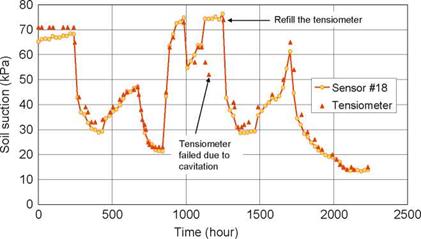Suction Plate
A simple laboratory variant of the tensiometer method for measuring matric suction of fine-grained soils uses a semi-pervious sintered glass plate. A small soil sample
|
Fig. 3.15 Comparison between laboratory soil suction measurements with tensiometers and TCS. Reproduced with permission of D. Fredlund |
is placed on the glass plate and covered immediately with a cap so that the vapour pressure around the soil comes to equilibrium with the suction in the soil, preventing drying. On the other side of the plate de-aired water is provided in a small chamber. The soil attempts to suck water across the glass plate from the chamber but the only way this can happen is by water being drawn into the chamber via a narrow-bore tube. In the tube, beyond the water, there is a small length of mercury and beyond that, air and a small hand-operated suction pump and vacuum gauge (Fig. 3.16). As the water (and, hence, the mercury) is pulled towards the soil, the operator applies a partial vacuum to oppose this and to keep the mercury in the same position. Once the operator no longer needs to apply additional suction, the suction in the soil specimen and applied by the operator are in equilibrium and the suction value may be read from the gauge. Typically, readings may be obtained in around 15 min (though this depends a lot on the soil type). The device is limited to measuring in the range from atmospheric pressure to approximately 70 kPa of suction.
|
|








Leave a reply